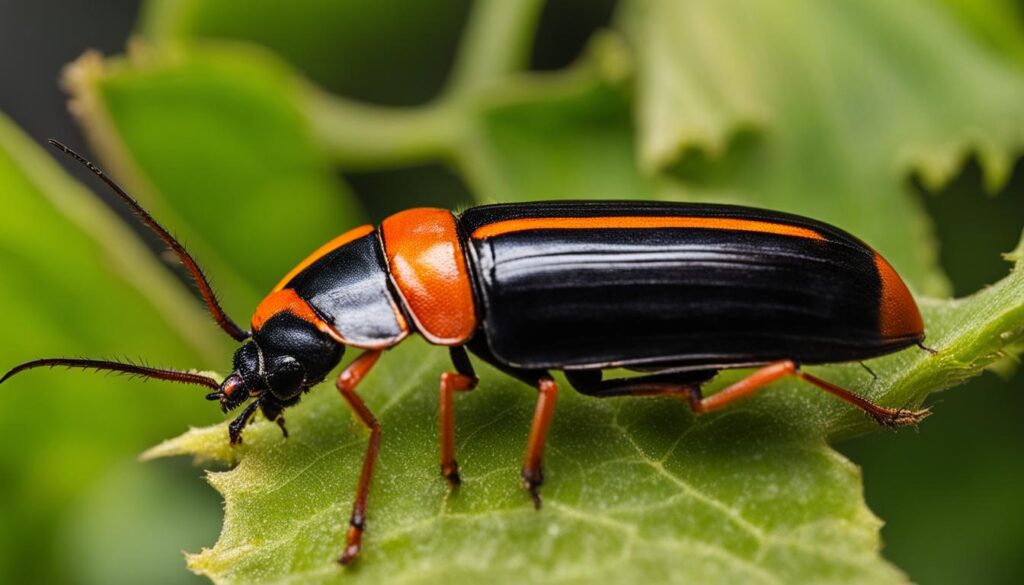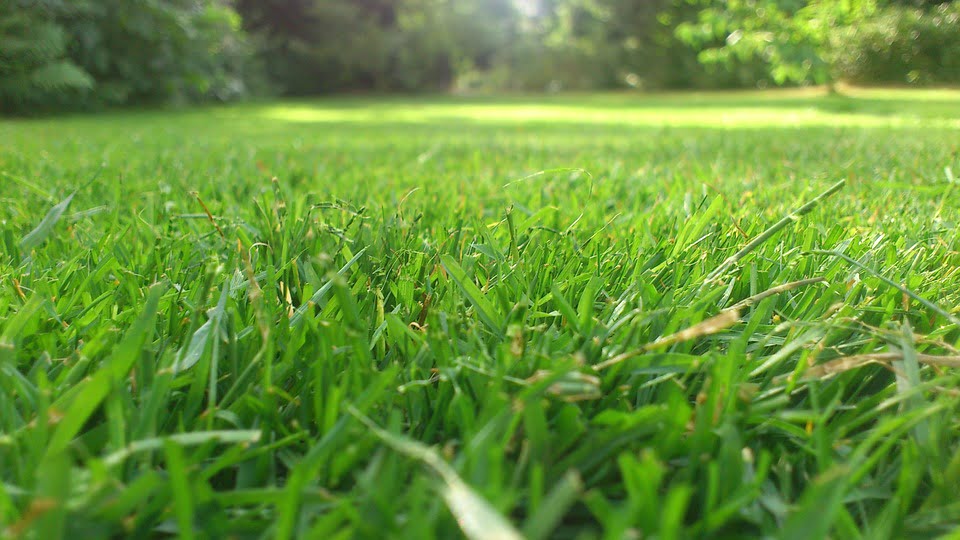Welcome to our homeowner’s guide on understanding the vine borer beetle. This destructive pest, also known as the squash vine borer (Melittia satyriniformis), can wreak havoc on your squash, pumpkins, cucurbits, and melons. It’s crucial for homeowners to identify the signs of infestation, learn about their life cycle, and implement effective control methods to safeguard their gardens.
The vine borer beetle is a formidable foe, but armed with knowledge and the right strategies, you can protect your plants and preserve your harvest. In this comprehensive guide, we’ll delve into the description and life cycle of the vine borer beetle, the damages it causes, how to identify infestations, prevention and control methods, as well as alternative insecticides and biological control options.
By understanding the vine borer beetle and implementing preventive measures, you can ensure a thriving garden free from the devastating effects of this pest. Let’s dive in and equip yourself with the tools and knowledge needed to combat the vine borer beetle.
Key Takeaways:
- Identify signs of vine borer beetle infestation, such as wilting plants and shiny green or yellow frass in the stems.
- Learn about the vine borer beetle’s life cycle, from eggs to larvae to adult beetles, and understand their preferred hosts.
- Implement preventive measures like crop rotation, field sanitation, and cultural techniques to reduce the population of vine borer beetles.
- Explore biological control methods, such as introducing parasitic wasps, to naturally manage vine borer beetle populations.
- Consider using alternative insecticides like kaolin clay to repel vine borer beetles in organic gardening.
Description and Life Cycle of the Vine Borer Beetle
The vine borer beetle, particularly the squash vine borer (Melittia satyriniformis), is a common and troublesome pest that can wreak havoc on your squash, pumpkins, cucurbits, and melons. To effectively combat these destructive insects, it’s important to understand their description and life cycle.
Starting with their appearance, squash vine borer eggs are small, brown, and flattened. The larvae, on the other hand, have a white body with a brown head. They possess eight pairs of appendages, including five pairs of prolegs that aid them in tunneling through plant stems.
When they emerge as adults, the squash vine borer can be mistaken for wasps due to their metallic green front wings and orange and black bodies. These captivating creatures overwinter as pupae and emerge into adults in the latter part of June. They lay their eggs on the stems of plants, and once hatched, the larvae tunnel into the stems, feeding on your plants for approximately four weeks. Afterward, they burrow into the soil to pupate, only to emerge as adults the following year. In certain southern states, there may even be two generations of vine borers in a single year.
Vine Borer Beetle Life Cycle:
- Small, brown, flattened eggs laid on plant stems
- Larvae tunnel through stems, feeding for about four weeks
- Larvae burrow into soil to pupate
- Adults emerge the following year
Understanding the life cycle of the vine borer beetle is crucial in formulating effective control methods and preventing infestations. By staying vigilant and knowing what to look for, you can protect your garden from these destructive pests, ensuring the health and vitality of your plants.
Damage Caused by the Vine Borer Beetle
The vine borer beetle poses a significant threat to your garden plants, especially squash, pumpkins, cucurbits, and melons. Understanding the damage caused by these pests is crucial in order to mitigate their impact and protect your crops. When the vine borer beetle infests your plants, it tunnels through the stems, disrupting the flow of nutrients and water. This tunneling weakens the plants, making them more vulnerable to secondary infections.
One of the most noticeable signs of a vine borer beetle infestation is wilting plants. As the beetles tunnel through the stems, the plants are unable to receive the necessary nutrients and moisture, resulting in wilting. Another important indicator is the presence of shiny green or yellow frass (excrement) within the stems. When inspecting your plants, pay close attention to the stems for any entry holes surrounded by frass. These entry holes are evidence of the beetle larvae’s activity.
It’s important to note that the damage caused by the vine borer beetle can extend beyond wilting and frass. If the borers tunnel into the fruit, it can lead to early vine senescence and fruit infestations. Stunted growth and reduced yield are common consequences of such damage. To protect your plants and prevent these negative effects, it’s essential to implement effective control measures to combat vine borer beetle infestations.
Remember: vigilant monitoring and early intervention are key to minimizing the damage caused by vine borer beetles. Regularly inspect your plants, especially the stems, for any signs of wilt, frass, or entry holes. By identifying the infestation early on, you can implement appropriate control methods and safeguard your garden from the destructive impact of vine borer beetles.
Identification and Detection of Vine Borer Beetle Infestations
Being able to identify and detect vine borer beetle infestations is crucial in effectively managing and preventing damage to your plants. By recognizing the signs early on, you can take prompt action to protect your garden. Here are some key identification tips and detection methods:
- Wilting plants: One of the most common signs of a vine borer beetle infestation is the sudden wilting of your plants. If you notice plants that were once healthy and thriving start to droop and wilt, it could be a red flag.
- Shiny frass in stems: Another clue to look for is shiny green or yellow frass within the stems of your plants. Frass is the excrement that the vine borer beetle larvae leave behind as they tunnel through the stems.
- Entry holes and frass: Inspect the stems for entry holes surrounded by frass. These holes are an indication that the larvae have burrowed into the stem.
- Presence of adult beetles or eggs: Keep an eye out for adult vine borer beetles or their small, brown eggs on your plants. Adult beetles may hover around the plants or lay their eggs on the stems.
Regularly inspecting your plants and staying vigilant for these signs will help you detect vine borer beetle infestations early, allowing you to take immediate action to control the population and limit the damage.
Prevention and Control Methods for Vine Borer Beetle
When it comes to dealing with the vine borer beetle, prevention is key in maintaining a healthy garden. By implementing a few effective control methods, you can protect your plants from infestation. Here are some strategies to consider:
- Rotating crops: By rotating your crops each year, you can disrupt the life cycle of the vine borer beetle. This practice helps to reduce the population of overwintering beetles and minimizes the risk of infestation.
- Destroying crop residues: Clearing away plant debris and crop residues after harvest can eliminate potential hiding places for vine borer beetles. Removing these materials reduces the chance of attracting and harboring pests.
- Practicing field sanitation: Keep your garden clean and tidy by removing any fallen fruits or damaged plants. Regularly inspect the area and dispose of any infested plant material to prevent the spread of vine borer beetles.
- Removing eggs and larvae: Check your plants regularly for the presence of vine borer beetle eggs or larvae. If you spot any, carefully remove them from the stems to prevent an infestation from taking hold.
In addition to these preventive measures, there are physical barriers and cultural techniques that can help deter vine borer beetles. Consider using row covers to create a physical barrier that prevents adult beetles from laying their eggs on your plants. Planting trap crops, such as squash varieties that are more attractive to vine borers, can lure the pests away from your main crops. Utilizing resistant varieties of squash and cucurbits can also reduce the risk of infestation.
While prevention is the best approach, there may be instances where insecticides are necessary to control vine borer beetles. Timing is crucial when using insecticides, as they need to be applied before the borers bore into the plants. Always follow the instructions on the product label and consider using organic or environmentally friendly options whenever possible.
By employing these prevention and control methods, you can safeguard your garden against the vine borer beetle and ensure the health and productivity of your plants.
Biological Control and Alternative Insecticides for Vine Borer Beetle
The vine borer beetle can wreak havoc on your garden, but there are effective methods to control its population. Biological control is a natural and environmentally-friendly approach that introduces natural enemies to combat the beetles. One of these natural enemies is the parasitic wasp, which lays its eggs on the vine borer larvae, effectively controlling the population. By utilizing biological control methods, you can reduce the reliance on chemical insecticides and create a more sustainable garden ecosystem.
Another alternative to traditional insecticides is the use of kaolin clay. Kaolin clay is a fine, white powder that is sprayed onto the plants to create a physical barrier. This barrier acts as a deterrent, preventing the vine borer beetles from landing and laying their eggs. Kaolin clay is safe for plants and does not harm beneficial insects, making it an ideal alternative for organic gardening.
Incorporating these alternative methods into your pest management strategy can provide long-term solutions for vine borer beetle control. By embracing biological control and utilizing alternative insecticides like kaolin clay, you can protect your plants without harming the environment or compromising the health of your garden.
Benefits of Biological Control and Alternative Insecticides
- Environmentally-friendly: Biological control methods and alternative insecticides reduce the use of harmful chemicals, promoting a healthier ecosystem in your garden.
- Sustainable solution: By implementing natural control methods, you can establish a long-term, self-sustaining balance between the vine borer beetles and their natural enemies.
- Safe for beneficial insects: Unlike traditional insecticides, biological control and alternative insecticides do not harm beneficial insects such as pollinators, allowing them to thrive in your garden.
- Organic gardening: These methods align with organic gardening practices, enabling you to grow fruits and vegetables without synthetic chemicals.
By embracing biological control methods and alternative insecticides, you can effectively manage vine borer beetle populations while maintaining a healthy and thriving garden.
Vine Borer Beetle’s Host Preference and Genetic Resistance
The vine borer beetle, also known as the squash vine borer, exhibits host preference when it comes to infesting plants. Understanding which plants are more susceptible to these beetles can help homeowners take appropriate preventive measures. Butternut squash and Royal Acorn squash are generally resistant to squash vine borers, making them less likely to be targeted. On the other hand, Black Zucchini and Pink Banana squash are more susceptible to infestations. Hubbard squash, in particular, is the preferred host of vine borer beetles.
To reduce the risk of infestations, it is advisable to choose resistant varieties of plants. Opting for squash types that have genetic resistance to vine borer beetles can significantly decrease the chances of an infestation occurring in your garden. By selecting resistant varieties, you can create a natural barrier that deters these pests from targeting your crops.
Implementing integrated pest management practices can also contribute to preventing vine borer beetle infestations. Crop rotation is a crucial aspect of pest control, as it disrupts the life cycle of the beetles and reduces their numbers. By rotating the crops in your garden each year, you can make it more challenging for vine borer beetles to locate and infest susceptible plants.
In summary, understanding the host preference of vine borer beetles and leveraging genetic resistance in plant varieties can help you safeguard your garden against these destructive pests. By selecting resistant plant varieties, practicing crop rotation, and implementing integrated pest management techniques, you can reduce the risk of vine borer beetle infestations and enjoy healthy, thriving crops.
Conclusion
In conclusion, understanding and effectively managing vine borer beetle infestations is crucial for homeowners who want to protect their gardens. By implementing preventive measures and control methods, you can minimize the damage caused by these pests and preserve the health of your plants.
Regular inspection of your plants is key to early detection. Look out for signs such as wilting, shiny frass in the stems, and entry holes surrounded by frass. By promptly removing and destroying eggs or larvae, you can prevent the infestation from spreading.
Prevention is always better than cure when it comes to vine borer beetles. Consider rotating crops, practicing field sanitation, and utilizing physical barriers like row covers. Additionally, adopting cultural techniques such as planting trap crops and using resistant varieties can help deter these pests.
Biological control methods, like introducing natural enemies and employing alternative insecticides, offer environmentally friendly options for managing vine borer beetle populations. Remember, timing is crucial when using insecticides to ensure effectiveness.
What are the Signs of Vine Borer Beetle Infestation and How Can Homeowners Identify Them?
The signs of vine borer beetle infestation include wilting plants, holes in stems, and frass at the base of the plant. Homeowners can identify them by inspecting plants for these symptoms, especially in the early morning or late evening. One effective method for controlling these pests is to learn how to kill vine borers using targeted insecticides or by physically removing them from plants.
FAQ
How can I identify a vine borer beetle infestation?
Look for signs such as wilting plants, shiny green or yellow frass in the stems, and entry holes surrounded by frass on the stems. The presence of adult beetles or their eggs on the plants is also an indication of infestation.
What are the prevention methods for vine borer beetles?
Rotate crops, destroy crop residues, and practice field sanitation to reduce the population of overwintering beetles. Removing and destroying any eggs or larvae found on the plants can help prevent infestation. Physical barriers, cultural techniques, and insecticides can also be used.
How can I control vine borer beetles using biological methods?
Introduce natural enemies like parasitic wasps, which lay their eggs on the vine borer larvae, helping to control the population of vine borer beetles. Alternative insecticides such as kaolin clay can also be effective in repelling the beetles.
Which plants are more susceptible to vine borer beetle infestations?
Hubbard squash is their preferred host, while Black Zucchini and Pink Banana squash are more likely to be targeted. Butternut squash and Royal Acorn squash are generally resistant, and Sweet Cheese and Green Striped Cushaw squash are moderately susceptible.
What should homeowners do to protect their gardens from vine borer beetles?
Regular inspection, early detection, and the use of physical barriers, cultural practices, and biological control methods can all contribute to reducing the impact of vine borer beetle infestations. Choosing resistant varieties and employing integrated pest management practices can further prevent infestations.












